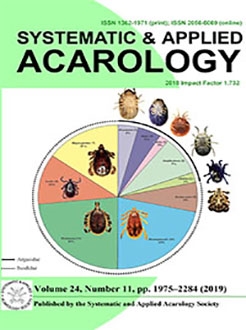As an independent species of chigger mites, Leptotrombidium deliense (Walch 1922) is the most important and powerful vector of scrub typhus (tsutsugamushi disease) in the south of China. Located in the southwest of China, Yunnan province, especially southern Yunnan, is an important focus of scrub typhus. A localized area, Jingha village in southern Yunnan, was chosen as the target site and a field investigation at the village was carried out for 12 consecutive months from April 2016 to March 2017. The investigation is an attempt to illustrate the small mammals host selection and seasonal fluctuation of L. deliense at a fixed geographical site within the focus of scrub typhus, and the selected localized area makes this possible. A total of 2,434 hosts were captured and examined, including rodents and some other “rodent-like” small mammals. Of the identified 15 host species, L. deliense was found on 73.33% of them (11 species of hosts), but 88.61% of the mites were from the Southeast Asian house rats, Rattus brunneusculus. Of 10 genera, 5 families and 4 orders of identified hosts, more than 80.00% of them were infested with L. deliense with a prominent cross infestation among different taxonomic categories of hosts, but the majority of the mites (96.60%) were collected from rodents (the order Rodentia), especially the rats in the genus Rattus (92.95%). It suggests that L. deliense prefers rodents (especially the Rattus rats) to some other small mammals although it has a low host specificity. Rattus brunneusculus is the major host of the mite in the investigated site. The female R. brunneusculus rats harbored more L. deliense mites than the male rats (P<0.01). The spatial distribution pattern of L. deliense on the hosts was determined as aggregated distribution. L. deliense mites were collected every month with two peaks (in July and October), belonging to the summer-autumn type. The first peak in July was much higher than the second peak in October. The monthly fluctuation of L. deliense was highly in accordance with that of the rainfall, which suggests the summer season with plentiful rainfall benefits the occurrence of this powerful vector of scrub typhus, L. deliense.
How to translate text using browser tools
27 November 2019
Host selection and seasonal fluctuation of Leptotrombidium deliense (Walch, 1922) (Trombidiformes: Trombiculidae) at a localized area of southern Yunnan, China
Yan Lv,
Xianguo Guo,
Daochao Jin,
Wenyu Song,
Rong Fan,
Chengfu Zhao,
Zhiwei Zhang,
Keyu Mao,
Peiying Peng,
Hao Lin,
Yue Zhao,
Tijun Qian,
Wenge Dong
ACCESS THE FULL ARTICLE
Acari
chigger mite
ectoparasite
host specificity
rodent
small mammal
Vector of scrub typhus





